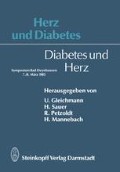Zusammenfassung
Die antidiabetischen Pharmaka werden hauptsächlich unter Berücksichtigung der Stoffwechselsituation beim Typ-II-Diabetes und damit in erster Linie unter präventiven Gesichtspunkten besprochen. Außerdem wird auf die Hypoglykämie und ihre Auswirkungen auf die koronare Herzkrankheit kurz hingewiesen.
Access this chapter
Tax calculation will be finalised at checkout
Purchases are for personal use only
Preview
Unable to display preview. Download preview PDF.
Literatur
Arzneimittelkommission der deutschen Ärzteschaft (1977) Indikationsstellung bei der Anwendung von Biguaniden. Dtsch Ärztebl 74:709 und 731
Asplund K, Wiholm BE, Lithner F (1983) Glibenclamid-associated hypoglycaemia. A report on 57 cases. Diabetologia 24:412
Adamson U, Lins PE, Efendic S, Hamberger B, Wajngot A (1984) Impaired Counter Regulation of Hypoglycemia in a Group of Insulin-dependent Diabetics with Recurrent Episodes of Severe Hypoglycemia. Acta Med Scand 216:215
Bachmann W, Mehnert H (Hrsg) (1983) Kombinationstherapie Insulin/Sulfonylharnstoff. Karger, Basel
Bachmann W, Lotz N, Mehnert H (1984) Kombinationstherapie Insulin/Sulfonylharnstoff (KOMB) bei Typ-II-Diabetikern mit Sekundärversagen einer Sulfonylharnstofftherapie. Akt Endokr 5:78
Berchtold P (1974) Herzinfarkt und Diabetes mellitus. Therapiewoche 24:2624
Berger W (1979) Present Status of Biguanides. Pharma-Kritik 1:9
Campbell IW (1984) Metformin and Glibenclamide: comparative risks. Br Med J 289:289
Clarke BF, Duncan LJP (1979) Biguanide treatment in the management of insulin independent (maturity-onset) diabetes: clinical experience with metformin. Res Clin Forums 1:53
Cohen RD (1979) The relative risks of different biguanides in the causation of lactic acidosis. Res Clin Forums 1:125
Cryer PE, Gerich JE (1983) Relevance of Glucose Counterregulatory Systems to Patients with Diabetes: Critical Roles of Glucagon and Epinephrine. Diab Care 6:95
Drost H, Grüneklee D, Kley HK, Wiegelmann W, Krüskemper HL, Gries FA (1980) Untersuchungen zur Glukagon-, STH— und Kortisolsekretion bei insulininduzierter Hypoglykämie bei insulinabhängigen Diabetikern (IDD) ohne autonome Neuropathie. Klin Wochenschr 58:1197
Hermann LS (1979) Metformin. A review of its pharmacological properties and therapeutic use. Diabete Metab 3:233
Husband DJ, Alberti KGMM (1983) »Streß« Hyperglycaemia during acute myocardial infarction: an indicator of pre-existing diabetes? Lancet II: 179
Jahnke K (1980) Indikation der Biguanid-Monotherapie bei Diabetes mellitus, Adipositas und Hyperlipoproteinämien. Metformintherapie. In: Mehnert H, Standl E. (Hrsg) Schattauer, Stuttgart New York, 59
Knick B, Knick J (1983) Diabetesbehandlung mit Biguaniden. MMW 125:739
Kühnau J (1983) Metformin in der Kombinationstherapie des Diabetes mellitus. Dtsch Med Wochenschr 108:1113
Leak D, Starr P (1963) The mechanism of arrhythmias during insulin-induced hypoglycemia. Am Heart J 63:688
Lucis OJ (1983) The status of metformin in Canada. Can Med Assoc J 128:24
Luft D, Schmülling RM, Eggstein M (1978) Lactic Acidosis in Biguanide—Treated Diabetics. Diabetologia 14:1
Madshad S, Hilsted J, Krarup T, Sestoft L, Christensen NJ, Faber OK, Tronier B (1982) Hormonal, Metabolic and Cardiovascular Responses to Hypoglycaemia in Type I (Insulin— Dependent) Diabetes with and without Residual B Cell function. Diabetologia 23:499
Mann JI (1984) Lines to Legumes: Changing Concepts of Diabetic Diets. Diabetic Med 1:191
Marble A (1955) Diabetes 4:296
Marks V, Rose FC (1981) Physiological responses to hypoglycaemia. In: Marks V, Rose FC (eds) Hypoglycaemia. Blackwell Scientific Publications, 2. Ed., p 69
Mehnert H (1961) Blutzuckersenkende Biguanidderivate in der Behandlung des Diabetes mellitus. 4e Congrès de la Fédération Internat, du Diabète, Genève, 10.-14. Juli 1961. Mèd et Hyg. 19, p 700
Montaguti U, Celin D, Ceredi C, Desovich GC (1979) Effiacy of the long-term administration of metformin in hyperlipidaemic patients. Res Clin Forums 1:95
Nikkilä EA (1984) Plasma lipid and lipoprotein abnormalities in diabetes. In: Jarrett RJ (ed) Diabetes and heart disease. Elsevier Amsterdam New York Oxford, p 133
Osei K, O’Dorisio TM, Falko JM (1984) Concomitant Insulin and Sulfonylurea Therapy in Patients with Type-II-Diabetes. Am J Med 77:1002
Sauer H (1961) Erfahrungen mit Insulin-Zink-Suspensionen in der Diabetesbehandlung. Med Welt 6:287
Sauer H (1985) Therapeutisches Vorgehen bei Sulfonylharnstoff-Sekundärversagen. Dtsch Med Wochenschr 110:27
Scarlet JA, Gray RS, Griffm J, Olefsky JM, Kolterman OG (1982) Insulin Treatment reverses the insulin resistance of Type-II-Diabetes mellitus. Diabetes Care 5:353
Schäfer G (1983) Biguanides: A review of history, pharmacodynamics and therapy. Diabetes et Métabolisme 9:148
Sperner W, Tillil H, Neumeyer H, Helmke K, Sauer H, Kübberling J (1983) Zuordnung diabetischer Patienten zum IDDM oder NIDDM. Abstracts zur 18. Jahrestagung der Deutschen Diabetes-Gesellschaft, Güttingen 12.-14. 05.1983. Akt Endokr Stoffwe 4:114
Steiner G, Morita S, Vranic M (1980) Resistance to insulin but not to glucagon in lean human hypertriglyceridemics. Diabetes 29:899
Unger RH (1983) Insulin-Glucagon Relationships in the Defense Against Hypoglycemia. Diabetes 32:575
Vogelberg KH, Gries FA, Jahnke K (1977) Diabetes mellitus und Hyperlipoproteinämie. In: Handbuchd. Inneren Medizin, 5. Aufl., Band 7, Teil 2 B. In: Oberdisse K. (Hrsg) Springer, Berlin Heidelberg New York, S. 117
Author information
Authors and Affiliations
Editor information
Editors and Affiliations
Rights and permissions
Copyright information
© 1986 Dietrich Steinkopff Verlag, GmbH & Co.
About this paper
Cite this paper
Sauer, H. (1986). Medikamentöse Therapie aus der Sicht des Diabetologen. In: Gleichmann, U., Mannebach, H., Sauer, H., Petzoldt, R. (eds) Herz und Diabetes. Steinkopff. https://doi.org/10.1007/978-3-642-85353-1_10
Download citation
DOI: https://doi.org/10.1007/978-3-642-85353-1_10
Publisher Name: Steinkopff
Print ISBN: 978-3-642-85354-8
Online ISBN: 978-3-642-85353-1
eBook Packages: Springer Book Archive

